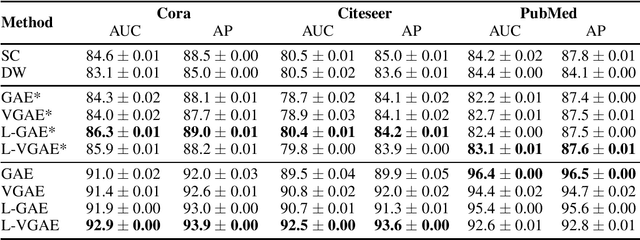Helena Andres-Terre
Decoupling feature propagation from the design of graph auto-encoders
Oct 18, 2019



Abstract:We present two instances, L-GAE and L-VGAE, of the variational graph auto-encoding family (VGAE) based on separating feature propagation operations from graph convolution layers typically found in graph learning methods to a single linear matrix computation made prior to input in standard auto-encoder architectures. This decoupling enables the independent and fixed design of the auto-encoder without requiring additional GCN layers for every desired increase in the size of a node's local receptive field. Fixing the auto-encoder enables a fairer assessment on the size of a nodes receptive field in building representations. Furthermore a by-product of fixing the auto-encoder design often results in substantially smaller networks than their VGAE counterparts especially as we increase the number of feature propagations. A comparative downstream evaluation on link prediction tasks show comparable state of the art performance to similar VGAE arrangements despite considerable simplification. We also show the simple application of our methodology to more challenging representation learning scenarios such as spatio-temporal graph representation learning.
Factorised Neural Relational Inference for Multi-Interaction Systems
May 21, 2019

Abstract:Many complex natural and cultural phenomena are well modelled by systems of simple interactions between particles. A number of architectures have been developed to articulate this kind of structure, both implicitly and explicitly. We consider an unsupervised explicit model, the NRI model, and make a series of representational adaptations and physically motivated changes. Most notably we factorise the inferred latent interaction graph into a multiplex graph, allowing each layer to encode for a different interaction-type. This fNRI model is smaller in size and significantly outperforms the original in both edge and trajectory prediction, establishing a new state-of-the-art. We also present a simplified variant of our model, which demonstrates the NRI's formulation as a variational auto-encoder is not necessary for good performance, and make an adaptation to the NRI's training routine, significantly improving its ability to model complex physical dynamical systems.
 Add to Chrome
Add to Chrome Add to Firefox
Add to Firefox Add to Edge
Add to Edge